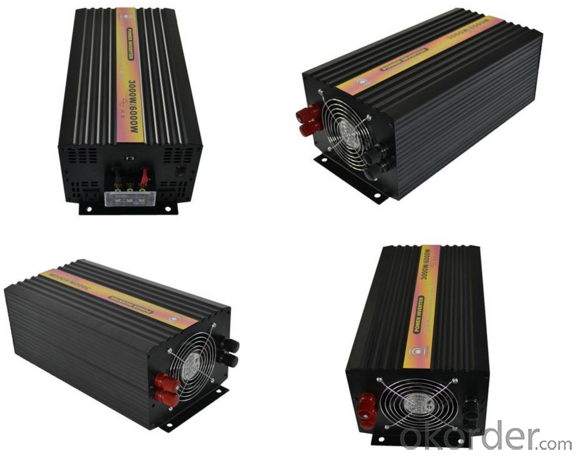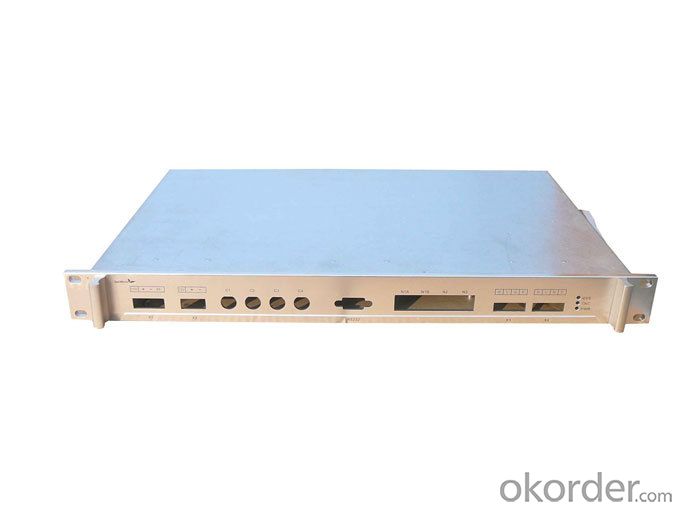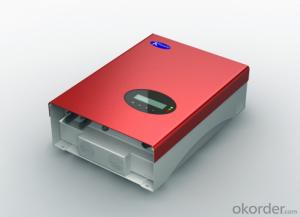Single Phase Inverter Second Generation 3.0k Solar Inverter made in China
- Loading Port:
- Shanghai
- Payment Terms:
- TT OR LC
- Min Order Qty:
- 0 watt
- Supply Capability:
- 10000 watt/month
OKorder Service Pledge
OKorder Financial Service
You Might Also Like
Description of Single Phase Inverter Second Generation 3k Solar Inverter
Solar ac power system consists of solar panels, charge controllers, inverter and battery; Solar energy does not include inverter dc power system. Inverter is a kind of power conversion device, inverter by incentives can be divided into self-excited oscillation inverter and separately excited oscillation inverter.
Features of Single Phase Inverter Second Generation 3k Solar Inverter
Standard 10 years warranty, 5-15 years optional
Built-in Gprs as option
Built-in Wifi as option
Smaller and lighter, only 9.6kg
High performance DSP for algorithm control
VDE-AR-N 4105 certification
New topology design
Dual MPPT design
Multi-button touch interface
LCD screen visible at night
Have anti-shading function
Advantages of Single Phase Inverter Second Generation 3k Solar Inverter
Longer life cycle
Plug and play
Free monitoring through our webportal
Very lower internal temperature
Easy transportation and installation
Faster CPU speed
Adjustable active and reactive power
Maximum conversion effciency up to 97.7%,Euro up to 97.0%
Real-time data readable at night
User friendly operation
Technical Data of Single Phase Inverter Second Generation 3k Solar Inverter
Type | Omniksol-3k-TL2-S |
Input(DC) | |
Max.PV Power | 3250W |
Max,DC Voltage | 500V |
Nominal DC Voltage | 360V |
Operating MPPT Voltage Range | 120-450V |
MPPT Voltage Range at Nominal Power | 150-450V |
Start up DC Voltage | 150V |
Turn off DC Voltage | 120V |
Max, DC Current | 18A/18A |
Max, Short Cicuit Current for each MPPT | 20A/20A |
Number of MPP trackers | 1 |
Number of DC Connection for each MPPT | 1 |
DC Connection Type | MC4 connector |
Output(AC) | |
Max,AC Apparent Power | 3000VA |
Nominal AC Power (cos phi = 1) | 3000W |
Nominal Grid Voltage | 220V/230V/240V |
Nominal Grid Frequency | 50Hz/60Hz |
Max, AC Current | 14.0A |
Grid Voltage Range* | 185-276V |
Grid Frequency Range* | 45-55Hz/55-65Hz |
Power Factor | 0.9 capacitive... 0.9 inductive |
Total Harmonic Distortion(THD) | <2% |
Feed in Starting Power | 30W |
Night time Power Consumption | <1W |
Standby Consumption | 6W |
AC Connection Type | Plug-in connertor |
Efficiency | |
Max,Efficiency | 97.7% |
Euro Efficiency | 97.0% |
MPPT Efficiency | 99.9% |
Safety and Protection | |
DC Insulation Monitoring | Yes |
DC Switch | Optional |
Residual Current Monitoring Unit (RCMU) | Integrated |
Grid Monitoring with Anti-islanding | Yes |
Protection Class | Ⅰ(According to IEC 62103) |
Overvoltage Category |
PVⅡ/Mains Ⅲ(According to IEC 62109-1)
|
Electricity Fuse Protection | Yes |
Reference Standard | |
Safety Standard | EN 62109, AS/NZS 3100 |
EMC Standard | EN 6100-6-1, EN 6100-6-2, EN 6100-6-3 EN 6100-6-4, EN 6100-3-2, EN 6100-3-3 |
Grid Standard | VDE-AR-N4105. VDE-0126-1-1,G83/1,EN 50438,RD1699,CEI 0-21, AS4777,C10/C11 |
Physical Structure | |
Dimensions | 343x281x150mm |
Weight | 9.9kg |
Environmental Protection Rating | IP 65 (According to IEC 60529) |
Cooling Concept | Internal fan convection |
Mounting Information | Wall bracke |
General Data | |
Operating Temperature Range | -25℃ to +60℃(derating above 45℃) |
Relative Humidity | 0% to 98%, no condensation |
Max. Altitude (above sea level) | 2000m |
Noise Type | <40dB |
Isolation Type | Transformerless |
Display | 3 LED ,Backlight, 4x20 Character LCD |
Data Communication | RS485(WiFi, GRPS integrated) |
Computer Communication | USB |
Standard Warranty | 10 Years (5-15 years optional) |
IMages of Single Phase Inverter Second Generation 3k Solar Inverter



FAQ
Q: Do you have the CE, TUV, UL Certification?
A: We’ve already passed all the tests, and any certificate is available.
Q: Have you ever sold your products to companies in my country?
A: Of course, we have customers in all general PV markets, but I think we should expand our market share along with the market growth.
Q: When did your company set up? You are a new company, how can I believe your quality?
A: We entered into Solar PV industry in 2005, now we have several plants in manufacturing of a-Si and c-Si panels, and our capacity is 220MW per year. Till now we have already passed all the tests by authorized laboratories, e.g. TUV, CE, UL.
Q: Can you help us install the module if we cooperate with you?
A: We haven’t entered into installation sector, but we have the plan in near future.
Q: How do you pack your products?
A: We have rich experience on how to pack the panels to make sure the safety on shipment when it arrives at the destination.
Q: Can you do OEM for us?
A: Yes, we can.
Q: Can we visit your factory?
A: Surely, I will arrange the trip basing on your business schedule.
- Q:How does a solar inverter handle low light conditions?
- A solar inverter handles low light conditions by continuously monitoring the amount of sunlight received by the solar panels. When light levels drop, the inverter adjusts its operation to maximize power output by optimizing the voltage and current levels. It uses advanced algorithms and power electronics to convert the available sunlight into usable electricity efficiently, ensuring that even in low light conditions, the solar system continues to generate power.
- Q:What is the maximum number of parallel inverters that can be connected?
- The maximum number of parallel inverters that can be connected depends on various factors such as the design and capacity of the inverters, the load being powered, and the electrical infrastructure. However, in general, there is no fixed maximum number as long as the inverters are properly sized, synchronized, and connected in a well-designed electrical system.
- Q:Can a solar inverter be used with a solar-powered emergency lighting system?
- Yes, a solar inverter can be used with a solar-powered emergency lighting system. The solar inverter is responsible for converting the direct current (DC) generated by the solar panels into alternating current (AC) which is required to power the emergency lighting system. This allows the system to store and utilize the solar energy effectively, ensuring uninterrupted power supply during emergencies.
- Q:Can a solar inverter be used with different types of solar panel mounting systems?
- Yes, a solar inverter can be used with different types of solar panel mounting systems. The solar inverter is designed to convert the direct current (DC) generated by the solar panels into alternating current (AC) that can be used to power appliances and electrical devices. Regardless of the mounting system, as long as the solar panels are connected to the solar inverter, it can efficiently convert the generated energy for use.
- Q:What is the expected lifespan of a solar inverter?
- The expected lifespan of a solar inverter typically ranges between 10 to 20 years.
- Q:What is the role of a cooling system in a solar inverter?
- The role of a cooling system in a solar inverter is to regulate and dissipate heat generated during the conversion of DC power from solar panels to AC power for use in homes or businesses. By maintaining optimal operating temperatures, the cooling system ensures the inverter's components do not overheat, which could lead to reduced efficiency, performance degradation, or even system failure.
- Q:What is the maximum DC input current that a solar inverter can handle?
- The maximum DC input current that a solar inverter can handle depends on the specifications and capabilities of the specific model. It can vary significantly, ranging from a few amperes to several hundred amperes, based on factors such as the power rating and design of the inverter.
- Q:What is the role of a power backup system in a solar inverter?
- The role of a power backup system in a solar inverter is to provide a reliable source of electricity during periods of insufficient sunlight or power grid outages. It ensures uninterrupted power supply to critical loads, such as essential appliances or equipment, by utilizing stored energy from batteries or alternative power sources. This backup system enhances the overall reliability and functionality of the solar inverter, making it more suitable for both grid-tied and off-grid applications.
- Q:Can a solar inverter be used in conjunction with a generator?
- Yes, a solar inverter can be used in conjunction with a generator. In fact, it is a common setup in hybrid systems where the solar panels generate electricity during the day, and the generator provides power during periods of low solar production or high energy demand. The solar inverter converts the DC power from the solar panels and the AC power from the generator into a usable form for the connected appliances and the grid. This combination allows for a more reliable and efficient power supply.
- Q:Can a solar inverter be used with a solar-powered cooling system?
- Yes, a solar inverter can be used with a solar-powered cooling system. The solar inverter is responsible for converting the direct current (DC) power generated by the solar panels into alternating current (AC) power, which is required to operate the cooling system. By connecting the solar panels to the inverter, the generated solar energy can be efficiently utilized to power the cooling system, making it a sustainable and eco-friendly solution.
1. Manufacturer Overview |
|
|---|---|
| Location | |
| Year Established | |
| Annual Output Value | |
| Main Markets | |
| Company Certifications | |
2. Manufacturer Certificates |
|
|---|---|
| a) Certification Name | |
| Range | |
| Reference | |
| Validity Period | |
3. Manufacturer Capability |
|
|---|---|
| a)Trade Capacity | |
| Nearest Port | |
| Export Percentage | |
| No.of Employees in Trade Department | |
| Language Spoken: | |
| b)Factory Information | |
| Factory Size: | |
| No. of Production Lines | |
| Contract Manufacturing | |
| Product Price Range | |
Send your message to us
Single Phase Inverter Second Generation 3.0k Solar Inverter made in China
- Loading Port:
- Shanghai
- Payment Terms:
- TT OR LC
- Min Order Qty:
- 0 watt
- Supply Capability:
- 10000 watt/month
OKorder Service Pledge
OKorder Financial Service
Similar products
New products
Hot products
Hot Searches
Related keywords






























